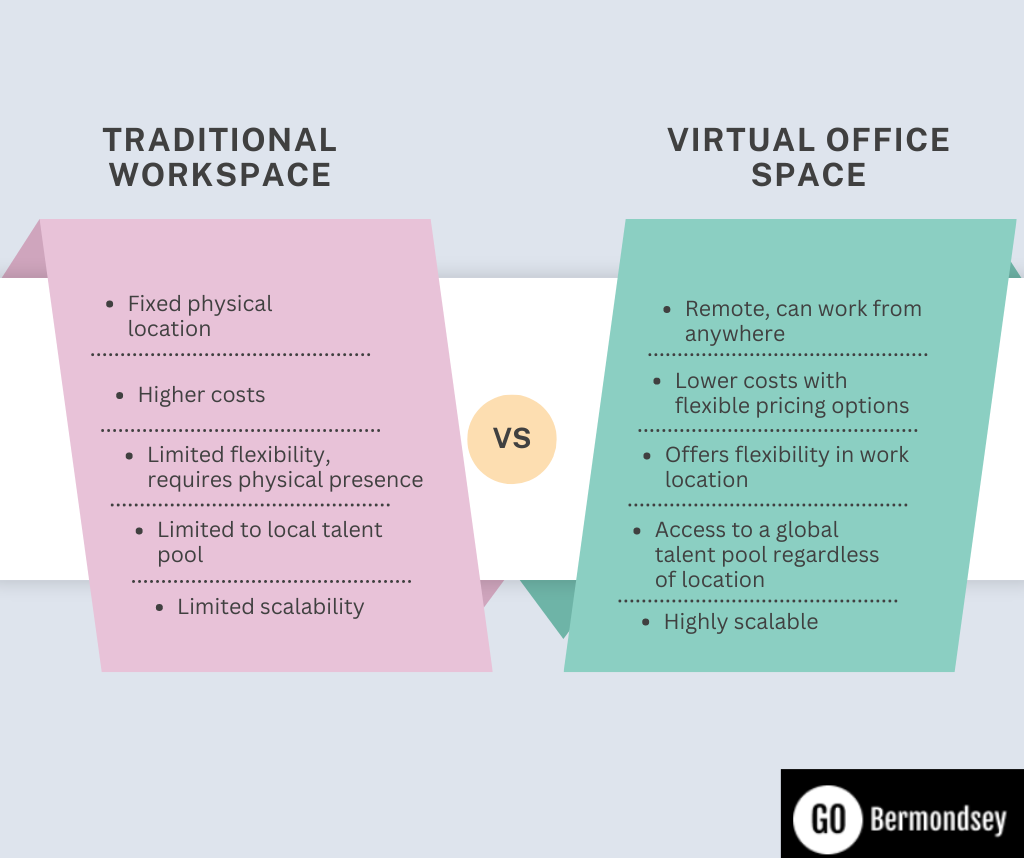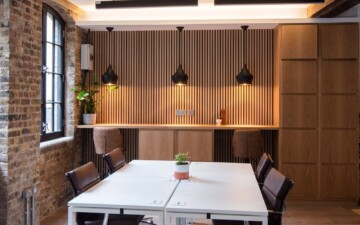In recent years, the nature of work has undergone significant changes, driven by remote work options, flexible schedules, and technological advancements. This transformation has led to a burning debate. Should we stick with traditional workspaces or opt for virtual office spaces as the way forward?
Supporters of the traditional office argue that in-person collaboration and structure foster productivity and company culture. On the other hand, advocates of virtual offices highlight the advantages of increased flexibility, reduced costs, and access to a global talent pool.
Interestingly, data indicates a growing preference for more dynamic workspaces like virtual offices. A recent report projects that the global virtual office market will reach $30.1 billion by 2030, signalling a significant uptick in virtual office adoption among businesses.
However, the choice between the two models ultimately depends on your organisation’s unique needs and priorities. In this article, we will delve deeper into the distinctions between traditional and virtual office spaces to help you determine the best fit for your organisation.
What is a Traditional Workspace?
A traditional workspace refers to a physical office space where employees gather to work regularly. It typically includes cubicles, meeting rooms, break areas, and other similar workspaces. This setup has been the norm for decades and is favoured by many established businesses.
What are the Benefits of Traditional Offices?
- Face-to-face interaction: Traditional offices facilitate real-time collaboration and communication among team members, fostering a sense of camaraderie and teamwork.
- Professional environment: Having a designated office space can improve your business’s brand image, instilling confidence in clients and partners.
- Infrastructure and amenities: Traditional workspaces often provide essential infrastructure, such as printing facilities, high-speed internet, and dedicated IT support, to ensure smooth operations.
What is a Virtual Office Space?
Virtual office space is a flexible and cost-effective solution that provides businesses with all the technology and amenities of a traditional office space without the need to own assets or lease physical premises directly. This setup has gained popularity in recent years, especially with the rise of remote work trends.
What are the Benefits of Virtual Office?
- Flexibility: Virtual offices offer unparalleled flexibility, allowing employees to work from their homes or any location with an internet connection. This flexibility promotes work-life balance and accommodates diverse work styles.
- Cost-effectiveness: Virtual office spaces offer significant cost savings compared to traditional office setups. While renting a physical office space and hiring support staff can be expensive, virtual offices provide access to amenities at a fraction of the cost.
- Global reach: Establish a professional presence in different locations without a physical office. This can lead to new business opportunities, plus it positions your company as a global player.
Traditional Workspace vs Virtual Office Space: What is the Difference?

The table below highlights the differences between traditional and virtual office spaces:
| Characteristic |
Traditional Workspaces |
Virtual Office Spaces |
| Location |
Fixed physical location |
Remote, can work from anywhere |
| Cost |
Higher costs (rent, utilities, maintenance, etc.) |
Lower costs with flexible pricing options |
| Flexibility |
Limited flexibility, requires physical presence |
Offers flexibility in work location |
| Scalability |
Limited scalability may require lease renegotiation |
Highly scalable, can easily adjust based on growth |
| Access to Talent |
Limited to local talent pool |
Access to a global talent pool regardless of location |
| Amenities and Services |
Typically includes amenities and support staff |
Offers various services on-demand (meeting rooms, etc.) |
How to Decide Which Office Space is Right for Your Business?
Every business is unique, driven by its own distinct set of goals and operational needs. As such, selecting the ideal office space is a critical decision that can profoundly impact productivity, efficiency, and overall success. But how does one decide which office space, either traditional or virtual, is best for their business? Here are a few key elements to consider:
Factor #1. Assess your Business Needs
Start by assessing your business requirements. Consider factors such as the size of your team, the nature of your work, client interactions, and future growth projections. This will help you decide if you need a traditional space for in-person collaboration or a virtual office address.
Factor #2. Budget Considerations
Understand your financial constraints and set a budget for office space. Traditional office spaces typically involve higher upfront costs, including rent, utilities, and maintenance fees. Virtual office spaces, on the other hand, prove to be more cost-effective, allowing businesses to save on overhead expenses.
Factor#3. Nature of Work
Evaluate the nature of your company’s work and how it aligns with different office settings. Certain tasks may require close collaboration and face-to-face interaction, making a traditional office environment more suitable. On the other hand, roles that demand flexibility and autonomy may thrive in a virtual office space.
Factor #4. Flexibility and Scalability
Determine whether your business needs flexibility and room for growth. Traditional office leases typically require long-term commitments, while virtual office spaces can offer more flexibility to scale up or down according to your needs.
Why do Startups prefer Virtual Office spaces?
Startups gravitate towards virtual office spaces primarily due to their cost-effectiveness. Unlike traditional workspaces with overhead costs for maintenance and furnishing, virtual offices come fully equipped, significantly reducing rental expenses. However, the appeal of virtual offices extends beyond cost savings, here are some other reasons why startups prefer virtual office spaces:
Reason #1: Flexibility
Virtual office spaces offer startups the flexibility to work remotely, allowing teams to collaborate from different locations. This flexibility enables employees to work from home or other preferred locations, promoting a better work-life balance and accommodating diverse working styles.
Reason #2: Scalability
Virtual office solutions are highly scalable, allowing startups to adjust their workspace needs as they grow. Whether expanding their team or downsizing, startups can quickly adapt their virtual office arrangements without the constraints of traditional leases, providing greater agility to respond to changing business requirements.
Reason #3: Meeting Facilities
Apart from essential services and amenities like Wi-Fi and video conferencing tools, virtual offices often include meeting rooms and coworking spaces. This allows startups to conduct client meetings, presentations, or team gatherings in professional environments, even if they primarily operate remotely. Having access to such facilities enhances the startup’s credibility and brand image.
Reason #4: Professional Image
Virtual office spaces provide startups with a professional business address and phone number, enhancing their credibility and legitimacy in the eyes of clients, partners, and investors. This aspect is crucial for startups aiming to establish themselves in competitive markets.
Reason #5: Access to Talent
Several startups value virtual office spaces for their ability to access talent from diverse geographical areas. By operating remotely, startups can hire the best talent regardless of their location, fostering collaboration with skilled professionals who may not be locally available. This broad access to talent enhances innovation and drives the growth of startups.
List of Businesses that Thrive in Virtual Offices
Virtual offices offer flexibility and cost-effectiveness, making them ideal for various businesses. Here’s a list of businesses that thrive in virtual office spaces:
- Freelancers and solopreneurs
- Tech Startups
- E-commerce Businesses
- Digital Marketing Agencies
- Creative Agencies
- Consulting Firms
- Financial Services
GO Bermondsey: The Perfect Office Space that Suits Today’s Business Needs
At GO Bermondsey, we offer a range of flexible office solutions, from private offices for teams of all sizes to meeting rooms. Whether you need a dedicated workspace or a place to drop in and work, we’ve got you covered. Our offices are equipped with the latest technology and amenities to support your business operations. High-speed internet, modern meeting rooms, and ergonomic furniture ensure that you have everything you need to stay productive. Our transparent pricing plans and flexible contracts make it easy to find a solution that fits your budget.
Ready to take your business to the next level with an exemplary office solution in London? Get in touch with GO Bermondsey today!






